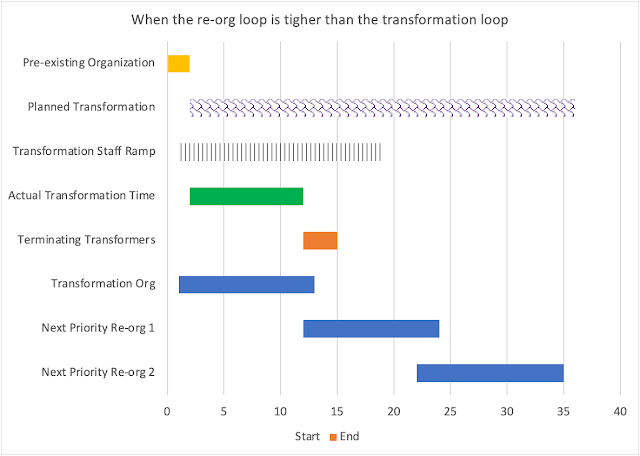Companies can punish those that buy in to transformation
Companies can accidentally teach people that being "all in" on transformative efforts is risky and potentially career-limiting (CLM). They do this because joining a transformation or reshaping puts those same people on the "most likely to get laid off" list when the company's senior leadership changes direction. This behavior flips the risk-reward decision process by rewarding those that keep their heads down and those that "wait out" any changes. Passive resistance or inaction is more profitable than commitment.
Transformation initiatives spin up when companies recognize the need to change. They organize around the transformation as a top priority. This continues until the next prioritization cycle with its associated reorganization. The previous priorities including the transformation are de-prioritized. This de-prioritizes skills learned to support the transformation. Companies ramp up to transform and then ramp down those teams punishing those that bought into the transformation.
I worked at several banks that reorganized every 8-15 months. Regime changes occurred more rapidly than transformations can take hold or complete. Reorganizations happened inside the innovation/transformation cycle. This means that they declared victory or abandoned the effort with only partial results. Ending a cycle early is the right approach when you did the wrong thing and don't want to waste more money on a bad idea.
Priority changes drive staff reallocations. That is a good use of resources and people. The negative side of this is that companies cut the people working on the formerly top-priority transformation effort. They especially scale back on skills that were added for the transformation. Team members who step up to learn the new techniques and approaches become those most likely to lose their livelihoods.
Proposed Remedies
We can try and fix this at the program level or at the staff level.
- Stick with the program enough to let a transformation stick in some groups to measure the results. This can be hard when there is a reorganization that hands the transformation over to new people or people that didn't sign up for it.
- Give those that bought into the new mission the first shot at the interesting roles when the company re-prioritizes. This tells everyone that they will not be penalized if they jump in new directions. It shows that there are rewards for jumping in even when the company changes its mind. It retains the people who want to make things happen.
References
Just some google'd links
Revision History
Created 2023 04




Comments
Post a Comment